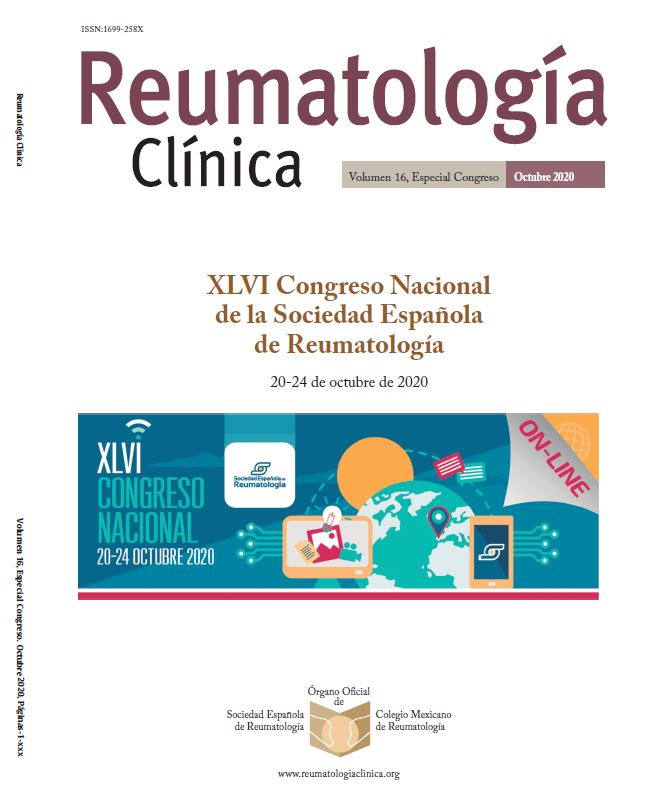P001 - The combined vaccination scheme against Streptococcus Pneumoniae is effective in Rheumatoid Arthritis patients treated with DMARD: Data from BIOBADASER 3.0
1Hospital Universitario de La Princesa. Madrid. 2Unidad de Investigación. Sociedad Española de Reumatología. Madrid. 3Hospital Clínic de Barcelona. 4Hospital Universitario Miguel Servet. Zaragoza. 5Hospital Doctor Negrín. Las Palmas de Gran Canaria. 6Hospital Carlos Haya. Málaga. 7Hospital General Universitario de Valencia. 8Hospital Universitario Virgen de las Nieves. Granada. 9Hospital de la Santa Creu i Sant Pau. Barcelona. 10Hospital Universitario de Alicante. 11Hospital San Jorge. Huesca. 12Instituto de Salud Músculo-esquelética. Madrid. 13Hospital Clínico de Santiago de Compostela.
Introduction: Respiratory tract infections are among the leading causes of hospitalization in rheumatoid arthritis (RA) and Streptococcus pneumoniae (Sp) is one of the most frequent pathogens involved. For these patients, the CDC recommends a combined vaccination scheme (CVS) using two types of Sp vaccines but evidence on its effectiveness remains insufficient.1
Objectives: To assess the impact of the combined vaccination scheme on the incidence of Sp infections in patients with RA treated with DMARD.
Methods: A cohort was nested in a register including patients with RA who were prescribed a bDMARD or tsDMARD -either naïve or switch- from 2000 to March 2019. The target outcomes were invasive pneumococcal disease (IPD) and all-cause community-acquired pneumonia (CAP), as defined by relevant MedDRA codes. Demographic and clinical features were also retrieved. Each participant centre informed about the date when they implemented a systematic Sp vaccination protocol and whether they were using the CVS. Those not adopting this practice were excluded from the analysis. Crude incidence rates (IR) were calculated for each outcome as well as for its combination (combined variable defined as “Sp infections”). Exposure was split into two periods, considering the date when the CVS was officially recommended in Spain (May 2015). The incidence rate ratio (IRR) comparing pre and post-implementation periods was estimated with a Poisson regression model adjusted for sex, age and comorbidities (Charlson Index).
Results: 1,704 patients were included, their characteristics are shown in table 1. One centre was excluded for not using any Sp vaccination protocol while the remaining ones reported using the CVS. Crude IRs by periods (pre and post CVS implementation) and age groups are shown in table 2. The IRR for the post-vaccination period after adjusting for age, sex and Charlson index was 0.40 (95%CI: 0.29-0.56), p < 0.001, (table 3).
|
Table 1. Baseline features of the cohort |
|
|
Demographics |
|
|
Age. years* |
60.6 (12.5) |
|
Female |
1356 (79.6%) |
|
Current smoking |
287 (16.8%) |
|
RA clinical characteristics |
|
|
Disease duration. years* |
9.1 (7.9) |
|
RF positive |
875 (74%) |
|
ACPA positive |
831 (71%) |
|
DAS28* |
4.6 (1.4) |
|
Other clinical characteristics |
|
|
Body Mass Index* |
27.5 (5.2) |
|
Charlson index* |
2.3 (1.5) |
|
Chronic pulmonary disease |
125 (9.3%) |
|
Diabetes mellitus |
147 (9%) |
|
*Data presented as mean (standard deviation). |
|
|
Table 2. Crude IRs (95% CI) of the outcomes of interest split by age |
|||||
|
Overall |
< 65 |
≥ 65 |
|||
|
Pre |
Post |
Pre |
Post |
Pre |
Post |
|
SP-Infections |
|||||
|
33 (27.4-39.9) |
12.7 (9.8-16.4) |
28 (22.4-35) |
11.8 (8.9-15.6) |
60.3 (42.4-85.8) |
19.5 (10.8-35.2) |
|
IPD |
|||||
|
- |
0.4 (0.1-1.6) |
- |
0.4 (0.1-1.8) |
- |
- |
|
All cause CAP |
|||||
|
23.6 (19.0-29.3) |
11.5 (8.8-15) |
18.7 (14.4-24.4) |
10.4 (7.7-14) |
50.8 (34.8-74) |
19.5 (10.8-35.2) |
|
Table 3. Poisson regression models |
||||
|
Crude Model |
p |
Adjusted Model |
p |
|
|
Period |
||||
|
Pre-Vac |
ref |
ref |
||
|
Post-Vac |
0.38 (0.28-0.53) |
< 0.001 |
0.4 (0.29-0.56) |
< 0.001 |
|
Sex |
||||
|
Male |
ref |
|||
|
Female |
0.89 (0.61-1.3) |
0.547 |
||
|
Age |
||||
|
≥ 65 y |
ref |
|||
|
< 65 y |
1.66 (1.14-2.43) |
0.009 |
||
|
Charlson Index |
1.18 (1.06-1.31) |
0.003 |
||
Conclusions: The incidence of Sp infections experienced a decrease in RA patients taking bDMARD or tsDMARD after the introduction of the stepwise combined vaccination scheme that is not related to age, sex or comorbidities.
Bibliografía
- Furer V, et al. Ann Rheum Dis. 2019;0:1-14.







